Vtne animal - Study guides, Class notes & Summaries
Looking for the best study guides, study notes and summaries about Vtne animal? On this page you'll find 341 study documents about Vtne animal.
All 341 results
Sort by
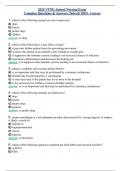
-
2024 VTNE Animal Nursing Exam Complete Questions & Answers (Solved) 100% Correct
- Exam (elaborations) • 33 pages • 2024
-
- $11.49
- + learn more
2024 VTNE Animal Nursing Exam Complete Questions & Answers (Solved) 100% Correct 1. which of the following animal are strict omnivores? a) dogs b) ferrets c) prairie dogs d) rabbits Answer: a) dogs 2. which of the following is a true effect of pain? a) it prevents further patient harm by preventing movement b) it places the animal in an anabolic state, leading to weight gain c) it suppresses the immune system, leading to an increased chance of infection d) it promotesinflammation a...
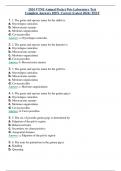
-
2024 VTNE Animal Pocket Pets Laboratory Test Complete Answers 100% Correct (Latest 2024) TEST
- Exam (elaborations) • 27 pages • 2024
-
- $11.49
- + learn more
2024 VTNE Animal Pocket Pets Laboratory Test Complete Answers 100% Correct (Latest 2024) TEST 1. 1. The genus and species name for the rabbit is a. Oryctolagus cuniculus b. Mesocricetus auratus c. Meriones unguiculatus d. Cavia porcellus Answer: a. Oryctolagus cuniculus 2. 2. The genus and species name for the hamster is a. Oryctolagus cuniculus b. Mesocricetus auratus c. Meriones unguiculatus d. Cavia porcellus Answer: b. Mesocricetus auratus 3. 3. The genus and species name for...
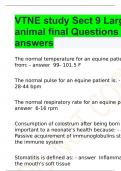
-
VTNE study Sect 9 Large animal final Questions and answers
- Exam (elaborations) • 15 pages • 2024
- Available in package deal
-
- $14.99
- + learn more
The normal temperature for an equine patient ranges from: 99- 101.5 F The normal pulse for an equine patient is: 28-44 bpm The normal respiratory rate for an equine patient is: 6-16 rpm Consumption of colostrum after being born is important to a neonate's health because: Passive acquirement of immunoglobulins strengthens the immune system Stomatitis is defined as: Inflammation of the mouth's soft tissue Pinkeye or contagious conjunctivitis in cattle is c...
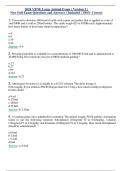
-
2024 VTNE Large Animal Exam ( Version 2 ) New Full Exam Questions and Answers ( Included ) 100% Correct
- Exam (elaborations) • 30 pages • 2024
-
Available in package deal
-
- $11.49
- + learn more
2024 VTNE Large Animal Exam ( Version 2 ) New Full Exam Questions and Answers ( Included ) 100% Correct 1. You need to deworm 100 head of cattle with a pour on product that is applied at a rate of 1ml/100lb and is sold in 250ml bottles. The cattle weigh 825 to 1050lb each. Approximately how many bottles of dewormer should youpurchase? a:4 b:8 c:10 d:16 Answer: A:4 2. Procaine penicillin is avaliable in a concentration of 300,000 IU/ml and is administered at 20,000 IU/kg.How much do...
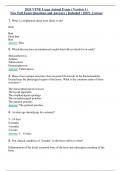
-
2024 VTNE Large Animal Exam ( Version 1 ) New Full Exam Questions and Answers ( Included ) 100% Correct
- Exam (elaborations) • 46 pages • 2024
-
Available in package deal
-
- $11.49
- + learn more
2024 VTNE Large Animal Exam ( Version 1 ) New Full Exam Questions and Answers ( Included ) 100% Correct 1. What is a frightened sheep most likely to do? Kick Run Head butt Bite Answer: Run 2. Which disease does an intradermal caudalskin fold test check for in cattle? Moraxella bovis Anthrax Tuberculosis Dermatophytosis Answer: Tuberculosis 3. Horses have unique structures that are paired diverticuli of the Eustachiantube located near the pharyngeal region of the horse. What is ...
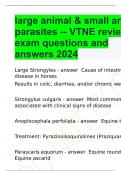
-
large animal & small animal parasites -- VTNE review exam questions and answers 2024
- Exam (elaborations) • 10 pages • 2024
- Available in package deal
-
- $13.99
- + learn more
Large Strongyles Cause of intestinal disease in horses Results in colic, diarrhea, and/or chronic weight loss Strongylus vulgaris Most commonly associated with clinical signs of disease Anoplocephala perfoliata Equine tapeworm Treatment: Pyrazinoisoquinolines (Praziquantel) Parascaris equorum Equine roundworm or Equine ascarid Causes disease in foals: - Poor weight gain - A heavy burden of large worms result in intestinal impaction - The larvae migrate through ...
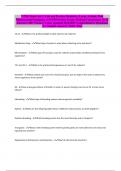
-
VTNE Study Set 2: Lab and Exotics, Dentistry, Large Animal, Pain Management/Analgesia, AAVSB Practice Exam, Medical Calculations Qs & Answers (100 %Score) Latest updated 2024/2025 Comprehensive Questions A+ Graded Answers | 100% Pass
- Exam (elaborations) • 248 pages • 2024
- Available in package deal
-
- $13.48
- + learn more
VTNE Study Set 2: Lab and Exotics, Dentistry, Large Animal, Pain Management/Analgesia, AAVSB Practice Exam, Medical Calculations Qs & Answers (100 %Score) Latest updated 2024/2025 Comprehensive Questions A+ Graded Answers | 100% Pass
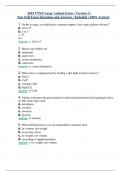
-
2024 VTNE Large Animal Exam ( Version 4 ) New Full Exam Questions and Answers ( Included ) 100% Correct
- Exam (elaborations) • 26 pages • 2024
-
Available in package deal
-
- $11.49
- + learn more
2024 VTNE Large Animal Exam ( Version 4 ) New Full Exam Questions and Answers ( Included ) 100% Correct 1. On the average, an adult horse consumes approx. how many gallons ofwater? a. 10 to 15 b. 5 to 7 c .25 d. 1 Answer: a. 10 to 15 2. Horses and rabbits are a. ruminants b. omnivores c. cecum fermenters d. carnivores Answer: c. cecum fermenters 3. What ratio is compromised by feeding a diet high in bran to horses? a. Na/Cl b. Ca/P c. vitamins A/D d. Mg/CO2 Answer: b. Ca/P ...

-
2024 VTNE Large Animal Exam ( Version 3 ) New Full Exam Questions and Answers ( Included ) 100% Correct
- Exam (elaborations) • 21 pages • 2024
-
Available in package deal
-
- $11.49
- + learn more
2024 VTNE Large Animal Exam ( Version 3 ) New Full Exam Questions and Answers ( Included ) 100% Correct 1. Cattle and swine display what type of estrous cycle? A. Polyestrous B. Seasonally polyestrous C. Diestrous D. Monoestrous Answer: Polyestrous 2. Which animal has a cotyledonary placenta? A. Cat B. Dog C. Horse D. Sheep Answer: Sheep 3. A pregnant mare has what kind of placentation? A. Zonary B. Cotyledonary C. Diffuse D. Discoid Answer: Diffuse 4. In dairy cattle the t...
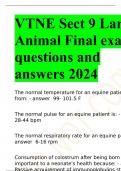
-
VTNE Sect 9 Large Animal Final exam questions and answers 2024
- Exam (elaborations) • 12 pages • 2024
-
- $14.99
- + learn more
The normal temperature for an equine patient ranges from: 99- 101.5 F The normal pulse for an equine patient is: 28-44 bpm The normal respiratory rate for an equine patient is: 6-16 rpm Consumption of colostrum after being born is important to a neonate's health because: Passive acquirement of immunoglobulins strengthens the immune system Stomatitis is defined as: Inflammation of the mouth's soft tissue Pinkeye or contagious conjunctivitis in cattle is c...

Study stress? For sellers on Stuvia, these are actually golden times. KA-CHING! Earn from your study resources too and start uploading now. Discover all about earning on Stuvia


